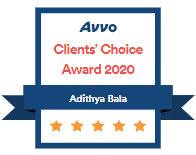
After a car accident, one of the first questions many people have is, “Who was at fault?” The answer is not always simple. In many cases, more than one driver shares responsibility for causing the crash. That is where the concept of comparative negligence comes into play. Arizona's comparative negligence law specifically governs how fault and damages are allocated in these situations.
If you or a loved one has been hurt in an auto accident, the right time to take action is now. Contact Bala Legal Services for a free consultation. Attorney Adithya Bala will carefully review the details of your case, walk you through your legal options, and work tirelessly to secure the compensation you deserve.
Comparative negligence is a system that looks at how much each party contributed to an accident. Instead of placing all the blame on one driver, the law assigns a percentage of fault to everyone involved. In a personal injury case, if the matter goes to trial, the jury determines how fault is allocated. The percentage of responsibility directly affects the damages awarded. This percentage then determines how much compensation each person can recover in personal injury claims.
Here is how it works in practice:
This approach is different from the contributory negligence rule, which is still used in some states:
Arizona’s Pure Comparative Negligence Rule
Arizona follows the pure comparative negligence rule. This means that no matter how much fault you share for an accident, you can still recover compensation for your injuries. Your percentage of fault simply reduces the amount you receive, and liability for damages is determined based on each party's assigned percentage of fault.
Here are the key points to understand:
To recover damages, you must show that the other party was at fault. This includes proving the defendant's breach of duty directly caused your injuries or damages. Types of damages affected by fault allocation include medical expenses, property damage, and economic losses such as lost wages.
This system ensures fairness in situations where more than one person contributed to an accident. Instead of leaving an injured person with nothing, Arizona law allows recovery that reflects the actual degree of fault.
Assigning fault in an auto accident is not always straightforward. Insurance companies, investigators, and sometimes courts look at many different sources of evidence to decide who is responsible and to what degree. In a personal injury case, if the matter goes to trial, the jury determines the percentage of fault for each party involved. The jury finds how fault is allocated, and this directly affects the damages awarded, as liability is assigned based on their findings.
Some of the most common factors used to determine fault include:
Because fault percentages directly affect the amount of compensation a person can receive, it is crucial to ensure the process is fair. Insurance companies often try to assign more blame to the injured driver to reduce payouts. Having an experienced attorney on your side helps protect against unfair fault assignments.
Comparative negligence often comes into play in everyday driving situations and other personal injury scenarios. Many accidents involve actions from both parties that contribute to the incident, which makes dividing fault an important step in the claims process.
Some of the most common examples include:
These situations show how even seemingly straightforward accidents can involve shared responsibility. Understanding this principle helps accident victims recognize that compensation may still be available even when they bear some fault.
Navigating a personal injury claim in Arizona involves several important steps, each of which can significantly impact your ability to recover compensation. After an accident, your first priority should always be your health. Seek immediate medical attention and keep detailed records of your injuries and related expenses.
The process typically includes:
The injury claim process can be complex, especially when comparative negligence is involved. By working with an experienced personal injury attorney, you can confidently move through each step while focusing on your recovery. Your legal team will protect your rights and fight for the compensation you deserve.
Comparative negligence can have a major impact on the outcome of an auto accident claim. While Arizona law allows injured people to recover compensation even if they share fault, insurance companies often use this rule to reduce payouts as much as possible.
Some of the tactics insurance companies may use include:
Without an attorney, accident victims may not realize how much these strategies affect the final recovery. Working with Attorney Adithya Bala makes a difference because he personally reviews each case, protects clients from unfair fault assignments, and focuses on securing fair settlements that put the client’s recovery first.
Navigating a car accident claim that involves comparative negligence can be overwhelming. Having an attorney who understands both the law and the tactics used by insurance companies is essential. As a law firm with a focus on personal injury claims, Bala Legal Services leverages the combined experience of its team to provide clients with knowledgeable and effective representation. Attorney Adithya Bala takes a client-first approach that focuses on both fair results and genuine care for the people he represents.
Here is what clients can expect when working with Bala Legal Services:
आदित्य के कानूनी कौशल और व्यक्तिगत करुणा का मिश्रण उन्हें पूरे टेम्पे और आसपास के समुदायों में दुर्घटना पीड़ितों के लिए एक विश्वसनीय वकील बनाता है।
एरिज़ोना में तुलनात्मक लापरवाही कैसे काम करती है, यह समझना उचित मुआवजा प्राप्त करने और आपके लायक से कम के साथ दूर जाने के बीच अंतर कर सकता है। भले ही आप किसी दुर्घटना के लिए आंशिक रूप से दोषी थे, फिर भी आपको अपनी चोटों के लिए हर्जाना वसूलने का अधिकार हो सकता है। सबसे महत्वपूर्ण बात यह है कि एक जानकार वकील का होना, जो यह सुनिश्चित कर सके कि गलती को निष्पक्ष रूप से सौंपा गया है और आपके दावे को सावधानी से निपटाया जाए।
बाला लीगल सर्विसेज में, अटॉर्नी आदित्य बाला दुर्घटना पीड़ितों को अनुचित बीमा रणनीति से बचाने और रिकवरी प्रक्रिया के हर चरण के माध्यम से उनका मार्गदर्शन करने के लिए प्रतिबद्ध हैं। उनका ध्यान हमेशा अपने ग्राहकों की भलाई पर रहता है, यह सुनिश्चित करते हुए कि उन्हें न केवल वह वित्तीय सहायता मिले जिसकी उन्हें आवश्यकता है, बल्कि वह व्यक्तिगत ध्यान भी मिले जिसके वे हकदार हैं।
यदि आप या आपका कोई प्रियजन ऑटो दुर्घटना में घायल हो गया है, तो मदद पाने के लिए इंतजार न करें। नि:शुल्क परामर्श के लिए आज ही बाला लीगल सर्विसेज को कॉल करें। आदित्य बाला आपके मामले की समीक्षा करेंगे, आपके विकल्पों की व्याख्या करेंगे और उस मुआवजे के लिए लड़ेंगे जिसके आप हकदार हैं।





